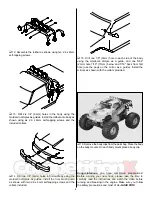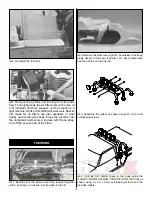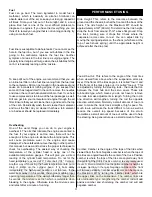
Shocks:
Changes in shock oils, springs, and pre-load on the
springs can dramatically change the way the car handles. A
thicker shock oil will make the truck turn faster but reduces
overall traction and handling over bumpy surfaces. Thinner
oil will increase traction at the expense of steering response
and the car will tend to roll more. In general, shock oils
between 20 and 40 weight will be best for your truck. You
should experiment some to see what oils work best for your
track and driving style. Shock springs affect the rate that the
suspension rebounds from a bump. We have supplied soft
springs that work under most conditions. Other springs are
available from DuraTrax. Pre-load on the springs means
that the springs are already compressed some so that the
suspension will rebound faster. Sometimes you will want to
pre-load one side when the track has turns all or mostly in
one direction, for instance an oval track. It will also increase
the ride height.
Slipper Clutch:
The slipper clutch is attached to the spur
gear on your truck, the large gear on the outside of the
transmission. This clutch will slip when too much power is
sent to the wheels. It has adjustable tension by turning the
nut on the shaft. This is designed to maximize traction on
various surfaces by slipping before the wheels do. To adjust
the slipper clutch, run the truck on the surface you plan to
race. If the rear wheels spin when full power is applied from
a stop, loosen the nut until the wheels do not spin any more.
If the wheels do not spin, tighten the nut until the wheels
spin and then loosen the nut some.
Before Each Run
•
Check for loosened screws on the truck. Engine vibration
will loosen some of the screws, particularly in the engine
mount area. Use thread lock on screws that thread into
metal parts or use a metal nut.
•
Inspect the air cleaner for a torn or damaged element.
Also look for dirt in the air cleaner element and wash it if
necessary.
•
Check the suspension and drive train for binding.
•
Inspect all of the wires for damage. Also check the
connectors to make sure all of them are tight and in the
proper place.
•
Check the fuel tank and fuel lines for leaks.
•
Before starting the engine, turn on the radio and make
sure the servos move easily and in the right direction.
•
Before running always check the condition of your radio
system batteries and replace/recharge if necessary.
After Each Run
•
Drain the fuel tank of any leftover fuel.
DO NOT
return it
to your fuel jug.
•
Put some after-run oil in the carb and turn the flywheel
several times to work the oil into the engine. This will
protect the engine from rusting, especially when stored
for a long period of time.
•
Check again for loosened screws.
•
CLEAN
the truck. Wipe off any oils that have collected
on the chassis, engine end exhaust. Oils will attract dirt
on the next run.
MAINTENANCE TIPS
18
0"
1"
2"
3"
4"
5"
6"
7"
0
10
20
30
40
50
60
70
80
90
100 110 120 130 140 150 160 170 180
Inch Scale
Metric Scale (mm)



































